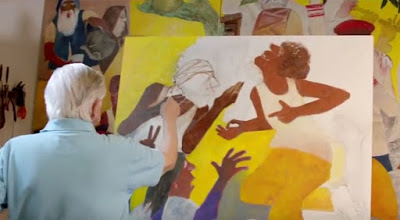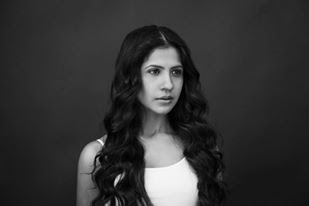 |
| (c) Sruti Harihara Subramanian |
(tg) Sruti Harihara Subramanian is a known actress and model in South India and now went on her personal journey being behind the cameras. With ‘A Far Afternoon – a painted saga by Krishen Khanna‘ she came to the 13th Indian Film Festival Stuttgart to present her documentary to the German audience after winning two Indian National Awards. The documentary is her first work behind the camera accompanying one of the legends in Indian art history – Krishen Khanna. It is not just another biography on Krishen Khanna but a journey film maker Sruti Harihara Subramanian undergoes together with him. theinder.net had the opportunity meeting her in Stuttgart to talk about her journey with Krishen Khanna and about her future plans.
(tg) Welcome to the 13th Indian film festival in Stuttgart! In your documentary ‚A Far Afternoon – A painted saga’ you are portraying legendary painter Krishen Khanna. The documentary won two National Awards – congratulations for this great achievement! Why did you choose this specific topic for your documentary and what lead you to shoot such a documentary on an artist, a painter?
(SHS) I’m keeping telling people that I’m an accidental documentary film maker. This work came to me, I didn’t go and search for it. The Piramal Art Foundation of producers found out that Krishen Khanna is starting off this interesting work. It had the potential to be a large painting, it could be possibly his masterpiece. So they didn’t want to miss out on the process. And Krishen Khanna himself is the most senior artist from India who is part of the modern art movement called the ‘progressive art movement’ in India. And he is the last few living artist of that generation. So it was very important in terms of art history to capture the moment. It started off as an archival project just to see how the artist is painting, what is coming out of the work, how large is it going to be. But over time and after spending time with Krishen Khanna having so many stories – he is 90 years old and his experience, not just with respect to his own art, but also the art of his friends and his colleagues he had so much to say.
 |
| (c) Piramal Art Foundation | Krishen Khanna |
Soon we realized that we had amazing content and nobody else has this since it was not a typical biography of Krishen Khanna. Anywhere you read about him you get the same set of stories: he was born in Pakistan, he studied in England and came back to India after partition – I mean the stories are the same. But we had the footage of him painting. It’s very rare that you get into the mind of an artist. So we thought we had something very precious. That’s when we decided we’ll make a documentary out of it. And through his process of creating this art work you eventually know the artist. So it’s not a direct kind of a biography but it is more about getting into the mind of an artist.
(tg) An artist usually has his own process – whether being a musician, a painter or an actor. It is not comparable to a regular 9 to 5 job. This are people with a creative mind and an individual lifestyle. How difficult was it to do the documentary with Krishen Khanna? What was the biggest challenge for you? And how was it to accompany such a legendary artist who actually lives in his “own world”?
 |
| Sruti with legendary painter Krishen Khanna |
(SHS) Before the set-up there was a lot of fear. You hear about artists being eccentric, artists not opening up in their creative process. And he is old. We didn’t know whether he is fit enough or a typical one of these cranky artists. Maybe he might yell at you for something. So I was scared if I would understand him. But I had gone to visit him for the first time before we started off shooting – just to know him and see the space where he works. And he is such a charming man. He is very welcoming and very hospitable. He loves people and he loves to have conversations. It was nothing one that would imagine of the stories one hears about artists. I mean, Krishen Khanna definitely stands out of all the creative art persons I have known. So he just made my life and my work very easy. It was as if I’ve known him for a long time. He exudes so much warmth, not just him but also his whole family, his wife and his son. Over time I was just walking in and out of his house like it was my own. And he is such a charismatic person even the way he looks. If you see the trailer and the film, he looks like a superstar. So even just for the fact about seeing a beautiful person on screen and a very articulated person, this just made my job as a film maker very easy. I just had to place my camera and he did what he had to do.
(tg) How long time did it take to shoot the complete 73 minutes documentary?
 |
| (c) Piramal Art Foundation | Krishen Khanna at work |
(SHS) When Krishen Khanna started doing his work, he said he knows what the concept of the painting is going to be. He can’t really say how big it’s going to be. Finally the painting landed up being a 20 feet art work. It was 5 panels put together to make the 20 feet art work. And I think even for me as a film maker I would say the same thing. I knew that this is what I wanted. I wanted to see the creation of this art work in front of my eyes and translate that to my audience. But I didn’t know how long it’s going to be. So finally we had decided. Krishen Khanna took about 6 months to paint the work. He started mid-way, we caught him at the third panel. It took us 8 months from there to finish the work.
(tg) Did you accompany the complete process from thereon till to the very end?
(SHS) Yes, from the start to finish even though we missed the first two panels. I would say it’s like a journey because that’s what I felt and that was what I was trying to translate on screen. The journey of each panel coming about what made him paint a certain thing and the suspense what he is going to paint next. So you get that sense of a journey. And finally when he finishes the painting, you get the feeling of travelling with him and his work.
(tg) In the trailer of your documentary, you have chosen the sentence ‘Evolution of a masterpiece’. What is the message behind it?
 |
| (c) Piramal Art Foundation |
(SHS) Even by making the trailer we had not completely finish the edit of the full film. But we knew it was an evolution in the sense in many ways. Directly, where you see one panel leading to the other, leading to the final fifth one. Finally you see a literally saga, a story being told in five panels. And that’s why we say a painted saga. He says that a lot of his inspiration comes from the old English literature where they can bring in a lot of characters and build stories around them and connect them to the next. So in many ways that’s why we said evolution – the evolution of the first panel leading to the second and so on. And indirectly, probably also the evolution of a 90 year old man as an artist from where he started. He was originally a banker and he was a part-time artist. But soon the urge to paint was so much and part of such a big moment in Indian art history that he finally quit his safe banking job and took the job of a full-time artist. I think it’s the evolution of that. An evolution of the themes and subjects that he uses which you get to know as you see the documentary. In any way it’s a journey, and there is no journey without change or evolution.
(tg) You are talking about changes and a journey. Now let’s talk about your personal journey. You have been into modelling, theatre and acting before you changed the side – now being behind the camera as a film maker. What was the main reason behind your decision?
(SHS) I’ve been a creative person and I was just taking up various opportunities coming my way. So as a young girl modeling came up and I took that up – I loved it! I was doing a lot of commercials and ads. I was always interested in dance and music on the stage as a performer. So theater was something that came naturally to me. That was a form of creative expression. But theater took up a lot of time in terms of rehearsals and things like that. But as a model and an actress in front of the camera there was always a bit of curiosity about what was happening behind the camera.
 |
| (c) Sruti Harihara Subramanian |
I started off assisting directors what goes behind the camera. And over time I couldn’t separate the two. I felt being in front of the camera and learning the job behind the camera helps you in front of the camera. You are able to understand what the directors are trying to say. And the same ways as a director I know what an actor goes through in front of a camera and what to get out of it if he or she has a problem. So for me over time the worlds kind of blurred. The two worlds were necessary to help me with the other to understand me the other world. But it’s just that my curiosity and my need to be more creative and explore. I think behind the camera gave me more opportunities I would say. And in terms of even as a documentary film maker it’s not just a creative expression, the journey I go through as a film maker. With documentaries I also have the advantage of learning my subject. Right now my subject was a legendary 90 years old painter and I got to know so much about art in that process. I think it’s a personal journey as well. He tought me a lot, he is so active in such an age. I got to learn a lot from this man who was my subject so it’s just not a journey or a creative process professionally but also personally you get to learn a lot. The documentary helped me with that.
(tg) What is your current project and what are your next projects? In which direction is your journey continuing after Stuttgart?
 |
| (c) theinder.net | On the red carpet in Stuttgart |
(SHS) Honestly, I never planned my life. I’ve being blessed by giving opportunities which I grabbed when I thought they are right. So right now the film has its own life. It is taking me to various beautiful cities like Stuttgart. We were in Stockholm, we were in New York, we have shown in several places in India itself. So it’s having its own life and I’m going with that flow. Meanwhile I’m also writing a script for a feature film and I hope to see that on big screens sometimes soon. I hope to find a producer for that. I also do corporate films and ad films for my bread and butter, small projects that come by. And I hope to do a lot more creative work when I have the time. That gives me the biggest hype to be on stage and perform.
(tg) … and maybe your feature film will be screened in Stuttgart at the next film festival!
(SHS) Yes (laughs), I would love to come back with my next film to Stuttgart. That’s the plan!
(tg) Thank you very much for your time and the wonderful interview. We wish you best of luck for your future projects and are looking forward to welcoming you back in Stuttgart again.
 |
| theinder.net with film maker Sruti Harihara Subramanian in Stuttgart |
Watch the trailer: ‚A Far Afternoon – a painted saga by Krishen Khanna








